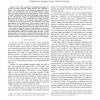VIROLOGY
2008
14 years 14 days ago
2008
We present a novel classification of computer viruses using a formalised notion of reproductive models based on Gibson's theory of affordances. A computer virus reproduction ...
IJSN
2007
14 years 15 days ago
2007
Abstract— Fast virus scanning is becoming increasingly important in today’s Internet. While Moore’s law continues to double CPU cycle speed, virus scanning applications fail ...
IJNSEC
2006
14 years 17 days ago
2006
The widespread use of the Internet has caused computer security to become an important issue. Currently, antivirus software is the primary mechanism that prevents computers from t...
BMCBI
2006
14 years 19 days ago
2006
Background: Most virus detection methods are geared towards the detection of specific single viruses or just a few known targets, and lack the capability to uncover the novel viru...
USS
2004
14 years 2 months ago
2004
Viruses and other malicious programs are an everincreasing threat to current computer systems. They can cause serious damage and consume countless hours of system administrators&#...
SP
1989
IEEE
14 years 4 months ago
1989
IEEE
In early November 1988 the Internet, a collection of networks consisting of 60,000 host computers implementing the TCP/IP protocol suite, was attacked by a virus, a programwhich b...
VIZSEC
2004
Springer
14 years 6 months ago
2004
Springer
This paper concentrates on visualizing computer viruses without using virus specific signature information as a prior stage of the very important problem of detecting computer vi...
ICSM
2009
IEEE
14 years 7 months ago
2009
IEEE
To defeat current commercial antivirus software, the virus developers are employing obfuscation techniques to create mutating viruses. The current antivirus software cannot handle...

